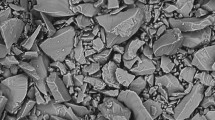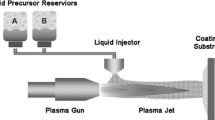Abstract
When spraying is conducted at ambient atmosphere, the entrainment of air cools the plasma jet and affects its expansion. It can also cause oxidation or chemical decomposition of the sprayed materials. Inert plasma spraying (IPS), generally conducted in an argon atmosphere, prevents these phenomena. However, the main drawbacks of IPS in comparison with air plasma spraying are the capital and operating costs. This paper presents a study in which nitrogen is used as a substitute for conventional argon atmosphere, thus reducing costs by 25 to 30%. Titanium carbide and niobium powders were sprayed in both argon and nitrogen atmospheres. Cryogenic cooling of the substrate was used during the spray process. This helps to maintain a low temperature in the chamber, produce thick coatings, and allows the use of substrate materials that are sensitive to heat.
The velocity, temperature, and composition fields of the argon-hydrogen plasma jet flowing in argon or nitrogen at atmospheric pressure are compared from numerical simulation. The adhesion, roughness, and microstructure of the niobium and TiC coatings produced in both atmospheres are discussed as well as their nitrogen content.
Similar content being viewed by others
References
J.R. Fincke, W.D. Swank, and D.C. Haggard, Plasma Spraying of Alumina: Plasma and Particle Flow Fields, Plasma Chem. Plasma Process., Vol 13 (No. 4), 1993, p 579–600
P. Roumilhac, A. Vardelle, M. Vardelle, J.F. Coudert, and P. Fauchais, Comparison of Ar-H2 and Ar-He Plasma Jets Produced by a D.C. Plasma Torch Working either in Air or in a Controlled Atmosphere Chamber at Atmospheric Pressure, Proc. of the 12th Int. Thermal Spray Conf., 4–9 June 1989 (London), I.A. Bucklow, Ed., Abington International, 1989, p 65–69
P. Proulx, “Modélisation Mathématique des Ecoulements Plasma-Particules,” Ph.D. thesis, Sherbrooke University, Quebec, Canada, July 1987 (in French)
A. Vardelle, P. Fauchais, and N.J. Themelis, Oxidation of Metal Droplets in Plasma Sprays, Advances in Thermal Spray Science and Technology, C.C. Berndt and S. Sampath, Ed., ASM International, 1995, p 175–181
A. Vardelle, N.J. Themelis, B. Dussoubs, M. Vardelle, and P. Fauchais, Transport and Chemical Rate Phenomena in Plasma Sprays, High Temp. Mater. Process., Vol 1 (No. 3), 1997, p 295–314
J.D. Mattei and O. Simonin, Estet software v. 3.1 Theoretical Handbook, Vol 1, Physical Modeling, EDF Report No. HE 44/92.38B, 1992, EDF-LNH (in French)
J.D. Mattei and O. Simonin, Estet software v. 3.1 Technical Handbook, Descriptif Informatique du Code ESTET, Version 3.1, EDF Report No. HE 44/93.20, 1992 (in French)
B.E. Launder and D.B. Spalding, The Numerical Computation of Turbulent Flows, Computer Methods in Applied Mechanics and Engineering, Vol 3, 1974, p 269–289
B.E. Launder and B.I. Sharma, Application of the Energy-Dissipation Model of Turbulence to the Calculation of Flow Near a Spinning Disc, Letters in Heat and Mass Transfer, Vol 1, 1974, p 131–138
R.C. Reid and T.K. Sherwood, The Properties of Gases and Liquids, 2nd ed., McGraw Hill, 1966, p 420–423, 483–486
C.H. Chang and J.D. Ramshaw, Modeling of Non-Equilibrium Effects in a High-Velocity Nitrogen-Hydrogen Plasma Jet, Plasma Chem. Plasma Proc., Vol 16, 1996, p 5S-17S
J.F. Coudert, M.P. Planche, and P. Fauchais, Velocity Measurement of D.C. Plasma Jets Based on Arc Root Fluctuations, Spray Torch, Plasma Chem. Plasma Proc., Vol 15 (No. 1), 1995, p 47–70
B. Dussoubs, A. Vardelle, K.-I. Li, M. Vardelle, and P. Fauchais, Injection and Trajectories of Particles in D.C. Plasma Spray Processes, in Proc. of the 12th Int. Symp. on Plasma Chemistry, J.V. Heberlein, D.W. Ernie, and J.T. Roberts, Ed., University of Minnesota, Minneapolis MN, 1992, p 1343–1348
J.F. Coudert, M.P. Planche, and P. Fauchais, Velocity Measurement of D.C. Plasma Jets Based on Arc Root Fluctuations, Plasma Chem. Plasma Proc., Vol 15 (No. 1), 1995 p 45–70
Z. Njah, J. Mostaghimi, and M.I. Boulos, Mathematical Modeling of the 3-D Mixing in an Induction Plasma Reactor, Int. J. of Heat Mass Transfer, Vol 36 (No. 16), 1993, p 3909–3919
M. Berardo, Controlled Atmosphere and Temperature Plasma Spraying Unit, CEA Internal Report, CEA-Institute of Technical Research and Industrial Development-CEA/Valrho, 1988 (in French)
J.F. Sacadura, Initiation Aux Transferts Thermiques, Tech. et Doc, Lavoisier, 1993, p 45–48 (in French)
D.R. Poirier and G.K. Geiger, Transport Phenomena in Materials Processing, TMS, 1994, p 288–292
M. Leylavergne, CEA Internal Report, CEA-Institute of Technical Research and Industrial Development-CEA/Valrho, 1988 (in French)
Author information
Authors and Affiliations
Rights and permissions
About this article
Cite this article
Leylavergne, M., Vardelle, A., Dussoubs, B. et al. Comparison of plasma-sprayed coatings produced in argon or nitrogen atmosphere. J Therm Spray Tech 7, 527–536 (1998). https://doi.org/10.1361/105996398770350756
Received:
Revised:
Issue Date:
DOI: https://doi.org/10.1361/105996398770350756




